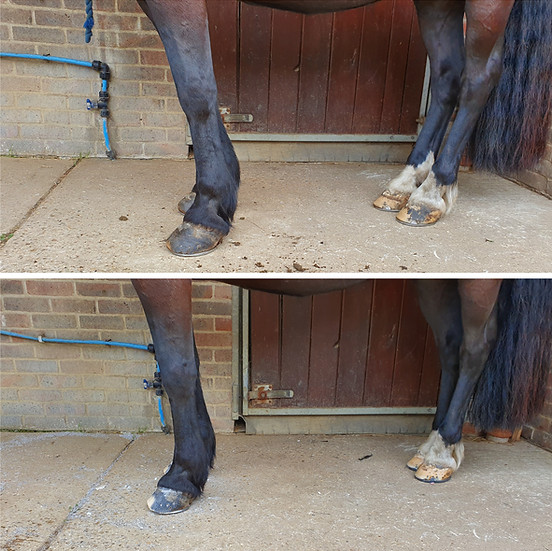


This hoof capsule had experienced a period of dorsal wall collapse resulting in the formation of cracks rising from the solar border (called grass cracks). As is often the case with chronic wall cracks, seedy toe began to form behind them and a larger area became affected resulting in lameness.
My approach was to thoroughly clean out the damaged hoof tissue, treat the area with copper sulphate crystals and acrylic rebuild and then shoe the foot supportively with a heart-bar shoe and leather pad. The horse was sound immediately but it took 5 months before the hoof capsule was perfectly healthy again.
Just as with humans, the platform from which a horse works is everything. One of the greatest advantages of shoes is the ability to change the position of that platform when the hoof capsule is diseased or weak in some way.
This horse was a highly performing dressage horse.
Positioning the hind shoes with lateral (outside) width significantly changed the stability that the horse and rider experienced and, in turn, increased the horse's ability to perform at his best.
In 2018 I began working towards my associateship exams. Candidates sit a theory examination and a practical examination and are required to submit a selection of case studies represented by a shoe board. This was mine.
Each of these shoes was handmade by me and almost all of them have been on horses I shod. This assessment is designed to test both the technical skills and applied knowledge of a farrier requiring proficiency in aluminium and steel welding and forging but also understanding about the effect that different elements of remedial shoes have on horses.
These shoes are for: Flexor tendon injury, navicular syndrome, medial hoof capsule collapse, severe solar puncture, hoof absess that degenerated into solar tissue prolapse, laminitis, superficial flexor injury, bone spavin, severe dorsal wall cracking, reverse rotation of pedal bone, hind-limb muscular atrophy and severe chronic hoof capsule injury.



These are a before (top photo) and after (bottom photo) of a first shoeing of a client that was experiencing low performance and weakness in school work. During this period I was particularly noticing how much of a difference shoeing hind feet with support can make to posture.
Posture isn't the same as dynamic balance of course but the one does help to indicate potential changes in the other. The shoes I changed to were much longer than the ones previously fitted and I also used a flatter section of shoe so that they wouldn't sink into the surface of the school as much.
This horse's performance did improve significantly with the increased support.
These are the before (left) and after (right) of a treatment technique for advanced and unstable (moving both at the solar and coronary borders) cracks.
I thoroughly cleaned the hoof exposing all damaged tissue and then treated it with copper sulphate and acrylic set in a Kevlar fabric. This combination gives the stability that the hoof capsule needs for the horn tubules to grow together again and the cracks to grow out.

The owner of this polo pony couldn't remember a time when this crack wasn't present and causing problems during the more than 10 years she'd played her.
I used the same treatment as described above but this time took the trouble to photograph the progress as the hoof grew down healthily. I had to repeat the treatment three times during the 11 months but the crack never reappeared and the pony never suffered with lameness associated with that crack again.
During the period that I was first experimenting with these techniques I was struck by how many problems and handicaps we end up settling for with our horses when, in many cases, simple changes can effect a change that will be lasting.
You can see why this is my go-to method for crack repair!
This before and after collage is a bit of a cheat because there wasn't really anything wrong with the previous shoeing - the horse had just been left too long.
The top photo illustrates well the dangers of letting a shod horse become overdue for shoeing. The distortions in the hoof wall and the solar-border collapse are the most obvious but the fact that the shoes had shifted forward resulted in sever bruising and lameness in the heels also.
My approach was to set the shoe back under the hoof and use a leather pad and magic cushion to ease the pressure. We did return to toe clipped shoes with this horse but shortened the shoeing cycle to 5 weeks.



Still my favorite shoeing treatment for chronic laminitis. These Imprint shoes are made of thermo-plastic that becomes malleable in hot water, can be formed as required by hand and then sprayed with freeze-spray to fix them in position.
I love that the shoes can be easily placed in a position most beneficial to the horse and can be fixed quickly so that even during an acute phase of laminitis relief can be given.
This pony did very well and we only used Imprint shoe a few times before transitioning into an aluminium and pad combination which served her well.
I've enjoyed working with donkeys over the years and had the management of a donkey sanctuary for a while. Many of the problems we encounter in donkey hooves are simply a result of neglect. Chronically un-trimmed hooves can result in irreversible damage to hoof and bone structures.
Sometimes treatment is as simple as a good trim (as below). Sometimes something a little more inventive is needed to help encourage the hoof to grow more supportively under the leg (as with the collage to the right).
In all cases, regular trimming cycles are absolutely key to good management and the best chance of avoiding more serious problems.




